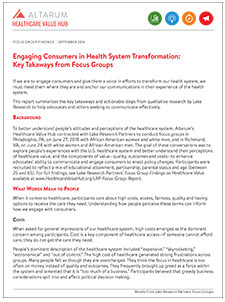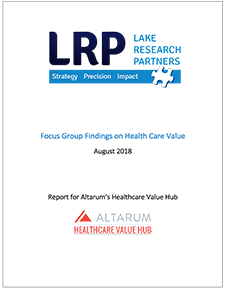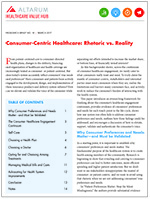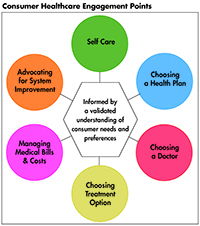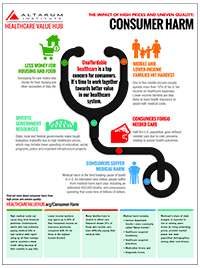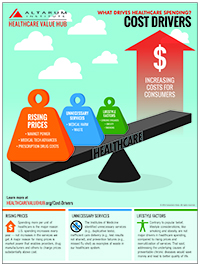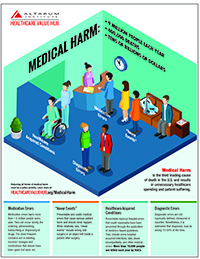Consumer Engagement in Healthcare
Resources
If we are to engage consumers and give them a voice in efforts to transform our health system, we must meet them where they are and anchor our communications in their experience of the health system.
Focus Groups
To better understand people’s attitudes and perceptions of the healthcare system, the Hub contracted with Lake Research Partners to conduct focus groups in June 2018. The goal of these conversations was to explore people’s experiences with the U.S. healthcare system and better understand their perceptions of healthcare value, and the components of value—quality, outcomes, and costs—to enhance advocates’ ability to communicate and engage consumers to enact policy changes.
A summary and full report describing the focus group findings are available. Consumers Union has also done some previous focus groups on engaging consumers.
State Surveys
The Hub’s Consumer Healthcare Experience State Survey (CHESS) is designed to elicit respondents’ unbiased views on a wide range of health system issues, including confidence using the health system, financial burden and views on fixes that might be needed. Reports from the CHESS survey can be found here.
Making Healthcare More Consumer-Centric
Across the continuum of consumers’ healthcare engagement, we rarely cater to what consumers really want and need. To truly claim the mantle of consumer-centric, stakeholders and interested parties must meet consumers where they are, realize the limitations and barriers many consumers face, and actively work to reduce the consumer’s burden of interacting with the health system.
This Research Brief and accompanying infographic explores the consumer healthcare engagement points, provides evidence of consumers’ preferences and needs for each touch point in the life-cycle, shows how our system too often fails to address consumer preferences and needs, outlines how these failings could be addressed, and encourages a discussion of how to elevate, support, validate and authenticate the consumer's voice.
The Hub's September 2017 webinar featured Elisabeth Rosenthal, editor in chief at Kaiser Health News and author of An American Sickness: How Healthcare Became Big Business and How You can Fight Back. She is also the author of the prizewinning series of articles in the New York Times: “Paying Till it Hurts.”
Rosenthal’s work illuminates the reason for our dysfunctional medical market but doesn’t stop there. She provides suggestions about the private and public actions that patients can take.
Taking Personal and Public Actions
There are many things that consumers can do when interacting with the health system. Maybe they won’t change the system but they will protect you from some of the more outrageous harm that befalls patients.
Below are some examples of personal actions you can take while interacting with the healthcare system, along with resources you can use get more value from your healthcare dollars.
During a Doctor Visit |
|
|
Ask: |
There is widespread agreement among researchers and doctors that many common procedures are unnecessary, including services that lack evidence that they produce better health outcomes compared to less-expensive alternatives. In fact, spending on unnecessary procedures has been estimated at 15 percent of total healthcare spending. Resources:
|
|
Ask: |
Unwarranted price variation for medical services is well documented. Chances are the doctor will not know how much a recommended procedure will cost. But it is important for your doctor to know about cost constraints you may face. There is growing recognition that doctors should be more aware of patient costs. Resources:
|
|
Ask: |
The fees you face may be very different depending on whether it isat the hospital, at a surgery center or the office. And some offices are actually part of the local hospital leading to surprise and expensive “facility fees”! Resources:
|
At the Pharmacy or Lab |
|
|
Ask: |
Surprisingly, you may have a brand drug prescribed when an equally good and cheaper generic is available. Also, pharmacists are sometimes prevented from volunteering these options. Be sure to ask! Resources:
|
If you are referred to other doctors or the hospital |
|
|
Ask: |
Will I be getting a separate bill from another provider? Can you recommend someone in my insurance network? Surprise medical bills from providers who aren’t part of your insurance network are astonishingly prevalent…and expensive. Resources:
|
During a hospital stay |
|
|
|
When you get your bill |
|
Resources:
|
|
Take Public Actions
From unaffordable charges, surprise billing, hospital safety issues and clinicians that are “gagged” from recommending lower priced options, patients are not getting a square deal. You can join myriad efforts around the country to work for policy and practice changes to address these patient concerns.
Surprise Medical Bills |
|
|
Background on this issue: Surprise medical bills occur when patients cannot avoid being treated by providers outside their health plan's contracted network. For example, the hospital is in-network but the anesthesiologist or emergency department doctor is out of network. |
Take Action: Consumer Reports’ Campaign on Surprise Medical Bills (share your story and find out what’s happening in your state) Vox's Sarah Kliff launched The Problem is the Prices project, which seeks consumer stories about hidden ER facility fees |
Patient Safety in the Hospital |
|
|
Background on this issue: While many hospitals are good at keeping their patients safe, some hospitals aren’t. As many as 440,000 people die every year from preventable errors in hospitals. |
Take Action: Consumer Reports’ Safe Patient Project (share your story take and action, and find out what’s happening in your state) |
Affordability of Drugs |
|
|
Background on this issue: prescription drug costs have been rising faster than inflation for years—especially brand-name and specialty drugs. Patients suffer from poor outcomes when they can’t comply with their doctor’s recommendations due to concerns about costs. |
Take Action: Patients for Affordable Drugs is an independent group where you can share your story and see proposed solutions. You can also share your drug price story at Consumer Reports. |
Hospital Not Meeting the Needs of Local Community |
|
|
Background on this issue: The majority of hospitals in the U.S. are nonprofit or tax-exempt. To keep this status the facilities must demonstrate their benefit to the communities they serve. |
Take Action: The Hospital Accountability Project is a project of the independent consumer group Community Catalyst. Here you can learn how to get involved with local hospital to address unmet community needs. |
Lack of Price Transparency |
|
|
Background on this issue: Many consumers face high deductibles or are uninsured, thus facing the full price of the medical service. It is critical yet very difficult to learn the cost of care before it is delivered. |
Take Action: Crowd source the prices you encountered at ClearHealthCosts.com |


